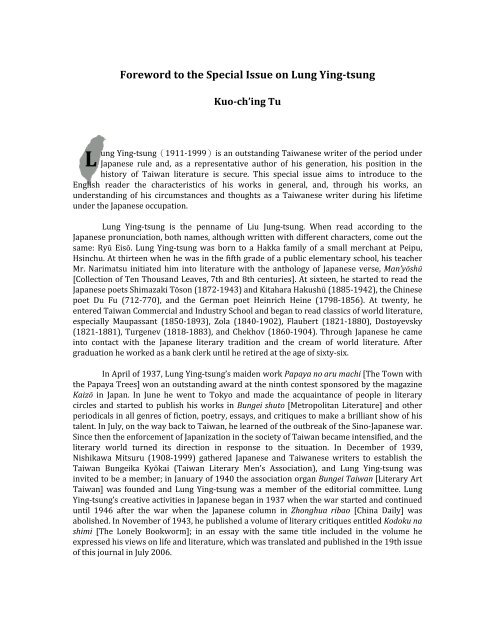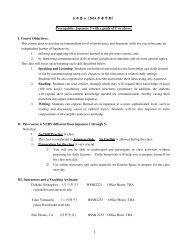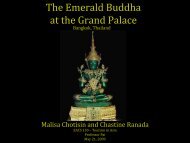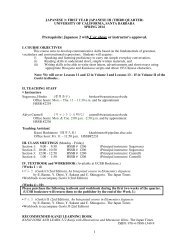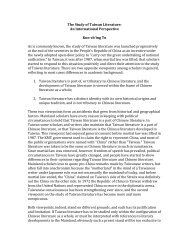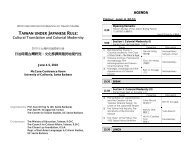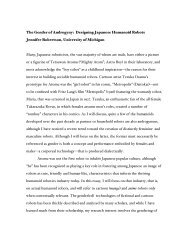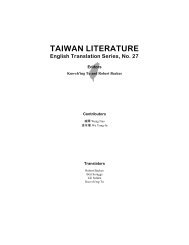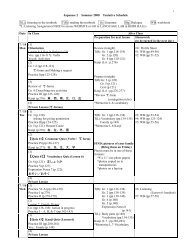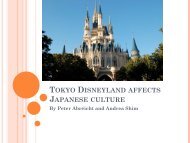L T - Department of East Asian Languages and Cultural Studies
L T - Department of East Asian Languages and Cultural Studies
L T - Department of East Asian Languages and Cultural Studies
Create successful ePaper yourself
Turn your PDF publications into a flip-book with our unique Google optimized e-Paper software.
Foreword to the Special Issue on Lung Ying-‐tsung Kuo-‐ch’ing Tu Lung Ying-‐tsung(1911-‐1999)is an outst<strong>and</strong>ing Taiwanese writer <strong>of</strong> the period under Japanese rule <strong>and</strong>, as a representative author <strong>of</strong> his generation, his position in the history <strong>of</strong> Taiwan literature is secure. This special issue aims to introduce to the English reader the characteristics <strong>of</strong> his works in general, <strong>and</strong>, through his works, an underst<strong>and</strong>ing T <strong>of</strong> his circumstances <strong>and</strong> thoughts as a Taiwanese writer during his lifetime under the Japanese occupation. Lung Ying-‐tsung is the penname <strong>of</strong> Liu Jung-‐tsung. When read according to the Japanese pronunciation, both names, although written with different characters, come out the same: Ryū Eisō. Lung Ying-‐tsung was born to a Hakka family <strong>of</strong> a small merchant at Peipu, Hsinchu. At thirteen when he was in the fifth grade <strong>of</strong> a public elementary school, his teacher Mr. Narimatsu initiated him into literature with the anthology <strong>of</strong> Japanese verse, Man’yōshū [Collection <strong>of</strong> Ten Thous<strong>and</strong> Leaves, 7th <strong>and</strong> 8th centuries]. At sixteen, he started to read the Japanese poets Shimazaki Tōson (1872-‐1943) <strong>and</strong> Kitahara Hakushū (1885-‐1942), the Chinese poet Du Fu (712-‐770), <strong>and</strong> the German poet Heinrich Heine (1798-‐1856). At twenty, he entered Taiwan Commercial <strong>and</strong> Industry School <strong>and</strong> began to read classics <strong>of</strong> world literature, especially Maupassant (1850-‐1893), Zola (1840-‐1902), Flaubert (1821-‐1880), Dostoyevsky (1821-‐1881), Turgenev (1818-‐1883), <strong>and</strong> Chekhov (1860-‐1904). Through Japanese he came into contact with the Japanese literary tradition <strong>and</strong> the cream <strong>of</strong> world literature. After graduation he worked as a bank clerk until he retired at the age <strong>of</strong> sixty-‐six. In April <strong>of</strong> 1937, Lung Ying-‐tsung’s maiden work Papaya no aru machi [The Town with the Papaya Trees] won an outst<strong>and</strong>ing award at the ninth contest sponsored by the magazine Kaizō in Japan. In June he went to Tokyo <strong>and</strong> made the acquaintance <strong>of</strong> people in literary circles <strong>and</strong> started to publish his works in Bungei shuto [Metropolitan Literature] <strong>and</strong> other periodicals in all genres <strong>of</strong> fiction, poetry, essays, <strong>and</strong> critiques to make a brilliant show <strong>of</strong> his talent. In July, on the way back to Taiwan, he learned <strong>of</strong> the outbreak <strong>of</strong> the Sino-‐Japanese war. Since then the enforcement <strong>of</strong> Japanization in the society <strong>of</strong> Taiwan became intensified, <strong>and</strong> the literary world turned its direction in response to the situation. In December <strong>of</strong> 1939, Nishikawa Mitsuru (1908-‐1999) gathered Japanese <strong>and</strong> Taiwanese writers to establish the Taiwan Bungeika Kyōkai (Taiwan Literary Men’s Association), <strong>and</strong> Lung Ying-‐tsung was invited to be a member; in January <strong>of</strong> 1940 the association organ Bungei Taiwan [Literary Art Taiwan] was founded <strong>and</strong> Lung Ying-‐tsung was a member <strong>of</strong> the editorial committee. Lung Ying-‐tsung’s creative activities in Japanese began in 1937 when the war started <strong>and</strong> continued until 1946 after the war when the Japanese column in Zhonghua ribao [China Daily] was abolished. In November <strong>of</strong> 1943, he published a volume <strong>of</strong> literary critiques entitled Kodoku na shimi [The Lonely Bookworm]; in an essay with the same title included in the volume he expressed his views on life <strong>and</strong> literature, which was translated <strong>and</strong> published in the 19th issue <strong>of</strong> this journal in July 2006.
modern intellectual temper <strong>and</strong> penetrating mind” have opened up “a more avant-‐garde <strong>and</strong> pr<strong>of</strong>ound world” for new Taiwan literature. 2)With his award-‐winning debut <strong>and</strong> as a rising writer recognized by the central literary circles in Japan in 1937, Lung Ying-‐tsung was active for a period <strong>of</strong> eight years from 1937 with “The Town with the Papaya Trees” published to the end <strong>of</strong> the war in 1945, altogether about twenty-‐three stories produced. In addition to Bungei Taiwan [Literary Art Taiwan] run <strong>and</strong> controlled by Nishikawa, the major periodicals that had published his works include Taiwan geijutsu [Taiwan Arts], Taiwan shin-‐minpō [Taiwan New People’s News], Bungei shuto [Metropolitan Literary Arts], Taiwan nichinichi shinpō [Taiwan Daily News], <strong>and</strong> Taiwan bungaku [Taiwan Literature], making him a well-recognized writer <strong>of</strong> the time. In January <strong>of</strong> 1940 when Literary Art Taiwan was founded, Lung Ying-‐tsung as a writer was invited to be an editorial committee member. The journal had sixty-‐two members, among whom sixteen were Taiwanese, <strong>and</strong> there were only two Taiwanese writers on the editorial committee: Lung Ying-‐tsung <strong>and</strong> Chang Wen-‐huan. The publisher <strong>and</strong> editor <strong>of</strong> this journal was Nishikawa, whose inclination to aestheticism <strong>and</strong> exoticism tended to develop a style emphasizing “artistry <strong>and</strong> local taste.” In other words, those “naichijin” (people <strong>of</strong> the metropole) living in Taiwan, in their creative works, wrote about their life experience in “gaichi” (overseas territory), expressed their nostalgia as foreigners, <strong>and</strong> described the local conditions, customs, <strong>and</strong> cultural scenes <strong>of</strong> native peoples in an attempt to develop the literature <strong>of</strong> Taiwan into an exotic “gaichi bungaku” (colonial literature) as an extension <strong>of</strong> the history <strong>of</strong> the motherl<strong>and</strong> Japan’s literature. According to a study by Luo Ch’eng-‐ts’un, Ryū Eisō kenkyū [A Study <strong>of</strong> Lung Ying-‐tsung], an M.A. thesis, Tsukuba University, 1984, Lung Ying-‐tsung’s position in the group <strong>of</strong> Literary Art Taiwan in the school <strong>of</strong> “colonial literature” seemed to be one <strong>of</strong> a misfit. Once he wrote a critique on the path taken by “gaichi bungaku” in Literary Art Taiwan [Vol. 1, No. 5, October 1940], saying that “in general most <strong>of</strong> them are works running counter to life.” In an article, “Taiwan bungaku no tenbō” [A View <strong>of</strong> Taiwanese Literature] published in Ōsaka asahi shinbun [Osaka Asahi Newspaper], February 1941, he brought forth his view on “gaichi bungaku” as follows: The so-‐called “gaichi bungaku” is not the kind <strong>of</strong> literature that aspires to make its presence felt in literary circles <strong>of</strong> this l<strong>and</strong>. It should be a literature written for this l<strong>and</strong>, not a literature in imitation <strong>of</strong> this l<strong>and</strong>, nor is it an exotic literature that gives a superficial description <strong>of</strong> a foreign l<strong>and</strong>. The nature <strong>of</strong> “gaichi bungaku” is neither nostalgia nor decadence, <strong>and</strong> it should be the literature written to advance the local literature by those who grew up in this l<strong>and</strong>, will be buried in this l<strong>and</strong>, <strong>and</strong> have a strong love for this l<strong>and</strong>. This kind <strong>of</strong> literature is not consumers’ literature but producers’ literature. (See Issue No. 19 <strong>of</strong> this journal, July 2006.) From the above we can see that the “gaichi bunkau” in Lung Ying-‐tsung’s mind is in fact “hondo bungaku” (nativist literature). He considered that the flower that bloomed in the colony Taiwan was not an extension <strong>of</strong> Japanese literature, but “a variety <strong>of</strong> the flower <strong>of</strong> Japanese literature.” It appears that his literary view was quite different from the “exoticism” perceived by the writers <strong>of</strong> the metropole Japan. Involved in the group <strong>of</strong> “gaichi bungaku,” his literary belief <strong>and</strong> the path he took for creative works looked united
with Japanese writers but differed at heart, <strong>and</strong> his solitary situation is not hard to imagine. 3)Lung Ying-‐tsung’s creative activities basically correspond to the war period, especially from 1941 when the situation entered preparedness for war, a time when writers could be requested at anytime to respond to the situation in cooperation with the military. Naturally the relation <strong>of</strong> Lung Ying-‐tsung’s works with the war has become a major concern <strong>of</strong> research among scholars. In 1943, Lung Ying-‐tsung prepared a collection <strong>of</strong> stories to be published but had to give it up due to interference from the government-general. According to Luo Ch’eng-‐ts’un, the collection contained ten stories dealing with the daily life <strong>of</strong> the common people in Taiwan; although there were two stories with the war situation for a setting, the rest were alo<strong>of</strong> from the times or society. The publication was banned perhaps because it was not relevant to the war. The literary characteristics <strong>of</strong> escaping from reality, remaining detached from the times <strong>and</strong> place with history nonexistent, namely the phenomenon <strong>of</strong> escapist literature, after the outbreak <strong>of</strong> the Sino-‐Japanese war, could also be found in the “gaichi bungaku” written by Japanese writers, or even in the works <strong>of</strong> Realist Taiwanese writers such as Chang Wen-‐huan <strong>and</strong> Lü Ho-‐jo. Once the society entered the set-‐up for war, literature had to cooperate with the state <strong>of</strong> affairs, <strong>and</strong> one could not but feel the spiritual burden <strong>of</strong> a heavy <strong>and</strong> boundless darkness on the back <strong>of</strong> the writers during that time. Following the advance <strong>of</strong> the “Japanization movement” until the end <strong>of</strong> the war (1937-‐1945), Lung Ying-‐tsung did not write a story with becoming a Japanese as its subject matter, <strong>and</strong> distinguished himself diametrically from other Taiwanese writers who contributed to the promotion <strong>of</strong> “kōmin bungaku” (imperial subject literature). However, the story “Gozen no gake” [A Precipice before Midday] describes an intellectual who sees at a train station the spectacle <strong>of</strong> a crowd sending <strong>of</strong>f soldiers leaving for the front <strong>and</strong> feels “unbearable shame,” because the soldiers are going to die for a noble cause <strong>and</strong> yet he is preparing to commit suicide over a woman. This story subtly suggests war cooperation <strong>and</strong> in his essays, critiques, <strong>and</strong> poems we do find some utterances in cooperation with the war. We have specifically selected some poems that reflect the war situation <strong>and</strong> a story that directly deals with the suffering caused by war, “Moeru onna” [Woman on Fire]. “Renbu no niwa” [The Wax-‐Apple Garden], published in 1943, describes the close relationship <strong>of</strong> a Taiwanese “I” <strong>and</strong> the family <strong>of</strong> a boy Fujisaki, taking care <strong>of</strong> each other without racial prejudice or class conflict. Later on Fujisaki goes to the battle front <strong>and</strong> when he returns, he doesn’t mention the war but expresses how much he has missed “I” <strong>and</strong> his family after the separation. The theme <strong>of</strong> the story apparently transcends race difference <strong>and</strong> the war situation at the time, <strong>and</strong> even implies anti-‐war sentiment. 4)Lung Ying-‐tsung’s “The Town with the Papaya Trees” not only was the work that brought the author instant fame but also was the prototype <strong>of</strong> his later works. The antagonist Chin Yūsan was a petty intellectual <strong>of</strong> colonial Taiwan, who struggled for life in the society, felt hopeless for the future, <strong>and</strong> in disillusion sank into skepticism <strong>and</strong> nihilism toward life. The theme <strong>and</strong> the type <strong>of</strong> character like Chin Yūsan continue to play a role in his later stories, including “Kō-‐ka” [The Huang Family], “Yoizuki” [Evening Moon], “Kaikō” [A Chance Encounter], <strong>and</strong> “Baku” [The Tapir].
The theme <strong>of</strong> characters suffering defeat is carried on in “Evening Moon,” published in 1940, which can be seen as an extension <strong>of</strong> “The Town with the Papaya Trees.” The antagonist Hō Eikon was an idealist in high school but lost enthusiasm for work after entering the society as a teacher, <strong>and</strong> in despair gradually fell into an abyss <strong>of</strong> skepticism, negative, <strong>and</strong> nihilistic, <strong>and</strong> eventually ended with the disintegration <strong>of</strong> his identity. The antagonist <strong>of</strong> “Tapir” not only found his dreams eaten by the beast but also his feelings, <strong>and</strong> completely fell into a cold <strong>and</strong> nihilistic world. However, in 1941 when “Shiroi sanmyaku” [White Mountains] was published, this type <strong>of</strong> character became a compromiser <strong>of</strong> fate <strong>and</strong> reality, seeing a dim light flickering in the vast darkness. At the end <strong>of</strong> 1941, to escape from the war situation, Lung Ying-‐tsung started to write a series <strong>of</strong> stories with To Nan’en as the protagonist, including “Shiroi sanmyaku,” “Ryūzetsuran to tsuki” [Century Plant <strong>and</strong> the Moon], <strong>and</strong> “Umi no yado” [A Home at Sea], <strong>and</strong> at the same time he started to write stories with Taiwanese women as the object, including “Shirarezaru kōfuku” [Happiness Unknown to Others], “Aru onna no kiroku” [The Record <strong>of</strong> a Woman], <strong>and</strong> “Gake no otoko” [A Man on the Cliff]. The protagonist To Nan’en was a meek <strong>and</strong> docile person, who “became a romantic in order to forget his reduced circumstances in reality.” Those stories have a strong characteristic <strong>of</strong> the “I-‐novel.” In the 1980s, Lung Ying-‐tsung acknowledged: “To Nan’en was me.” In this series <strong>of</strong> stories, the protagonist was seeking a way out, a belief to live on. In a story <strong>of</strong> “White Mountains,” which contains three independent short stories, when To Nan’en came to a small town on the east coast <strong>and</strong> saw a touching scene <strong>of</strong> an “unfortunate” family, an elder sister carrying her retarded younger brother on her back, <strong>and</strong> their mother watching the sea, he could not but feel “a picture <strong>of</strong> happiness combined with a heart-‐warming pr<strong>of</strong>ound affection.” In the ordinary life situation, once a true feeling <strong>of</strong> life is revealed, whether mother love, affection between parents <strong>and</strong> children, or intimate relations <strong>of</strong> lovers, once one discovers the good <strong>of</strong> human nature, he is surprised to feel “the happiness unknown to others,” which arouses a desire to cherish life <strong>and</strong> live on. “The Record <strong>of</strong> a Woman” <strong>and</strong> “Happiness Unknown to Others,” both published in 1942, depict the fate <strong>of</strong> a “simpu-‐a” (adopted daughter or adopted child bride), which was common in Taiwanese society. The former records the miserable life <strong>of</strong> a woman from one year old to the end <strong>of</strong> her life at fifty-‐four <strong>and</strong> describes her indomitable strength against her predestined fate; while the latter, which is even more touching, describes a woman who met a man plain-‐looking <strong>and</strong> physically ill but good-‐natured. They had pity for each other <strong>and</strong> got married. After more than twenty-‐years, the man passed away <strong>and</strong> she believed that she was “a victor <strong>of</strong> life,” <strong>and</strong> recalled that the man <strong>of</strong>ten told her to be close to nature, <strong>and</strong> gave her a faith in life: “There is a pr<strong>of</strong>ound revelation <strong>of</strong> life in nature, <strong>and</strong> nature will never betray us.” He was weak but good-‐hearted <strong>and</strong> had a deep attachment to nature <strong>and</strong> life. From their poor <strong>and</strong> ordinary life, the protagonist discovered the noble quality <strong>of</strong> human nature, which she cherished <strong>and</strong> from which she felt “the happiness unknown to others.” In a life that may look “unfortunate” to others, one feels “unknown happiness.” The love that penetrates human nature becomes the theme <strong>of</strong> Lung Ying-‐tsung’s fiction in the later period. His protagonists were able to transcend despair, overcome nihilism, <strong>and</strong> come out <strong>of</strong> the enclosed world to find a way <strong>of</strong> redemption to be connected with the outside world <strong>and</strong> social reality. Lung Ying-‐tsung’s fiction <strong>of</strong> the later period thus transcended the limits <strong>of</strong> the war situation <strong>and</strong> found a universal theme <strong>of</strong> literature: Notwithst<strong>and</strong>ing the hardships over time, love <strong>and</strong> nature support human life, which must live on.
Through his life, Lung Ying-‐tsung published more than one hundred sixty stories <strong>and</strong> numerous miscellaneous essays, poems <strong>and</strong> critiques, <strong>and</strong> can be considered the most prolific writer <strong>of</strong> the time under the Japanese occupation. In June 2006, the National Museum <strong>of</strong> Taiwan Literature hosted a celebration on the publication <strong>of</strong> Long Yingzong quanji [Complete Works <strong>of</strong> Lung Ying-‐tsung] in Chinese, eight volumes, <strong>and</strong> I happened to be in Taiwan to participate. Mr. Liu Chih-‐fu recalled the course his father had taken in pursuit <strong>of</strong> literature <strong>and</strong> mentioned that he didn’t know until grown up that his father was a famous writer during the Japanese period, revealing a great deal <strong>of</strong> secret hardship <strong>and</strong> sorrow Lung Ying-‐tsung must have stored up kept for long after the war. On that occasion I said that Taiwan Literature: English Translation Series would like to come out with a special issue <strong>of</strong> Lung Ying-‐tsung’s works in English. It took more than five years until now for my wish to be fulfilled. As mentioned above, regarding Lung Ying-‐tsung’s works, we have published in the previous issues <strong>of</strong> this journal two stories: “A Chance Encounter” (No. 2, December 1997) <strong>and</strong> “The Tapir” (No. 16, January 2005), <strong>and</strong> two essays: “A View <strong>of</strong> Taiwanese Literature” <strong>and</strong> “The Lonely Bookworm” (No. 19, July 2006). In this issue, we have selected six representative stories, including “The Town with the Papaya Trees,” which were all translated from Japanese; we thank the translators, Dr. Lili Selden <strong>and</strong> Pr<strong>of</strong>essor Robert Backus, the English editor <strong>of</strong> this journal, for their hard work <strong>and</strong> contributions. Due to a funding problem, from the last issue on, this journal has been published by the US-‐Taiwan Literature Foundation, a non-‐pr<strong>of</strong>it organization, <strong>and</strong> we are thankful for the editorial assistance provided by the Center for Taiwan <strong>Studies</strong>. We are also very grateful to Pr<strong>of</strong>essor Hsu Chun-‐ya <strong>of</strong> the National Taiwan Normal University <strong>and</strong> Ms. Hsu Su-‐lan <strong>of</strong> the National Museum <strong>of</strong> Taiwan Literature for their help in obtaining the copies <strong>of</strong> the original texts in Japanese in a timely manner that facilitated the process <strong>of</strong> publication. This journal has now been in publication for fourteen years, twenty-eight issues to date, <strong>and</strong> we know there are still many works <strong>and</strong> writers that deserve to be translated. Along with the development <strong>of</strong> the US-‐Taiwan Literature Foundation, we will exert every effort to continue to publish.


